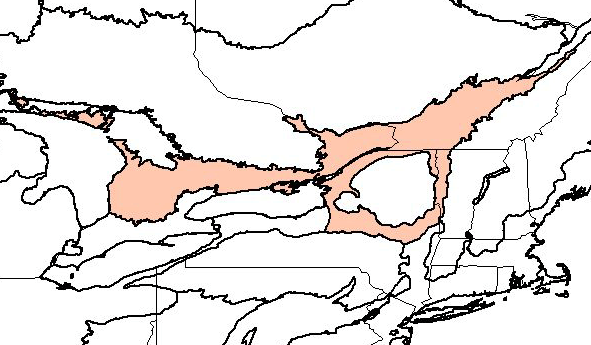
Orwell, Vermont looking towards Adirondack Mountains (c) 2008 Daniel C. Redondo
Bioimages home (click on an image to enlarge)
view
this page in its intended navigation context
Eastern Great Lakes lowland forests
(WWF
ecoregion NA0407)

Orwell, Vermont looking towards Adirondack
Mountains
(c) 2008
Daniel C. Redondo

Source of bioregions data:
Olson, D. M. and
E. Dinerstein. The Global 200: Priority ecoregions for global conservation. (PDF
file) Annals of the Missouri Botanical Garden 89:125-126.
Distinctiveness (1=highest,4=lowest): 4
(nationally important)
This ecoregion contains some unique habitat types, including alvar barrens and
ancient cliff white cedars. There are important wetland habitats and the
area is particularly rich in bird species.*
Conservation Status (1=most endangered, 5=most
intact): 1 (critical)
Pollution and suburban development have degraded this ecoregion severely and
less than 5% of the habitat remains intact. Intact habitat is highly
fragmented and protected areas are very small.*
 Tsuga
canadensis (eastern hemlock)
Tsuga
canadensis (eastern hemlock)
 Acer
saccharum
Acer
saccharum Acer
rubrum (red maple)
Acer
rubrum (red maple) Quercus
rubra
Quercus
rubra Fagus
grandifolia
Fagus
grandifolia Pinus
resinosa
Pinus
resinosa Pinus
strobus
Pinus
strobus Populus
deltoides (cottonwood)
Populus
deltoides (cottonwood) Populus
tremuloides (quaking aspen)
Populus
tremuloides (quaking aspen)Some views from the ecoregion
Sugar shack below a maple sugar (Acer saccharum)
knoll, Orwell, VT

Green mountains visible at far right.
(c) 2008
Daniel C. Redondo
hires
* Ricketts, T.H., E. Dinerstein, D.M. Olson, C.J. Loucks, et al. (1999) Terrestrial Ecoregions of North America: A Conservation Assessment. World Wildlife Fund - United States and Canada. Island Press, Washington, D.C. pp. 160-162.
Except as noted, images copyright 2002-2005 Steve Baskauf - Terms of use